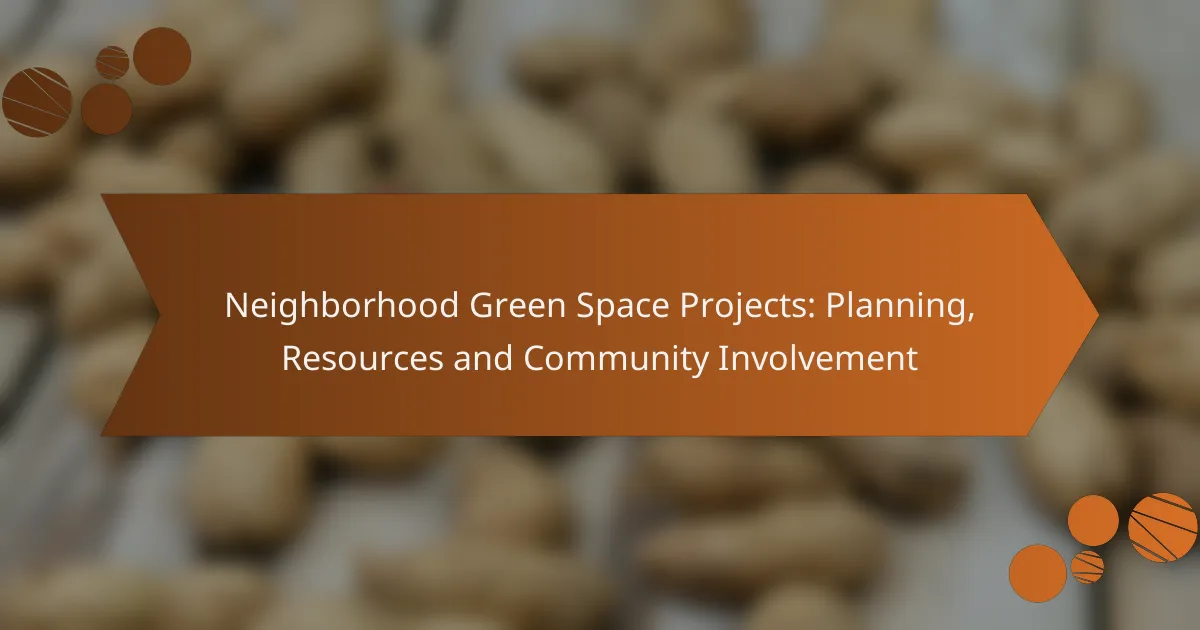Neighborhood green space projects play a vital role in enhancing urban environments, offering benefits such as improved air quality, recreational opportunities, and increased community engagement. In Los Angeles, initiatives like community gardens and parks revitalization are examples of how local residents can transform their surroundings. By actively participating through volunteering and forming partnerships, communities can ensure that their unique needs are addressed in the planning process. Access to resources such as city planning guidelines and funding sources further supports the successful development of these green spaces.
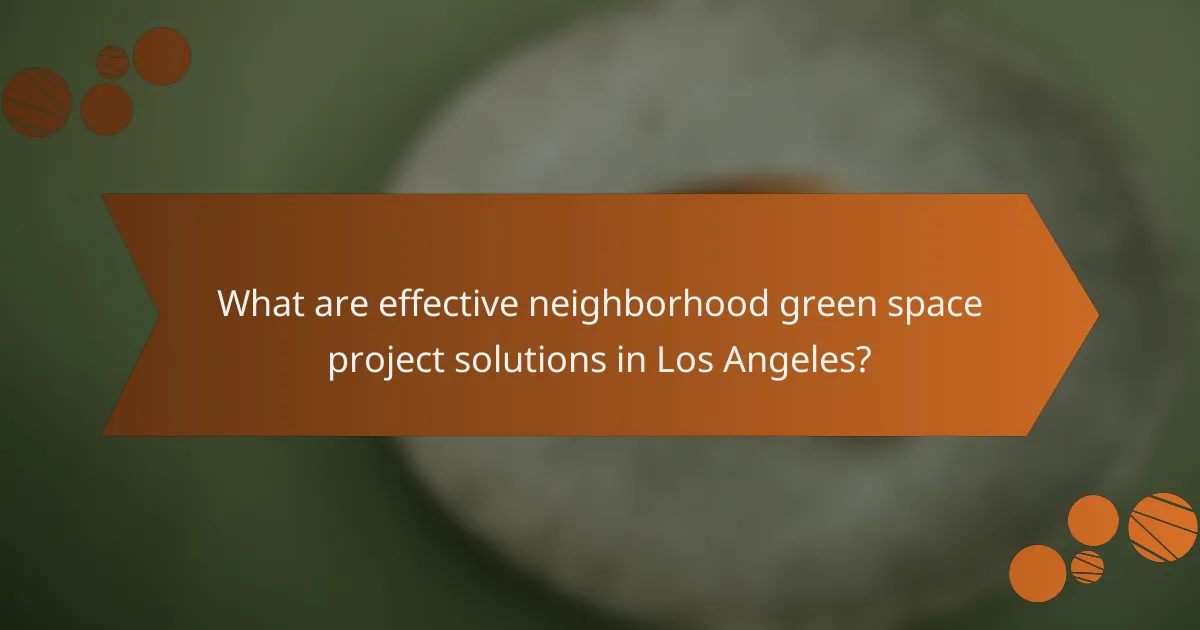
What are effective neighborhood green space project solutions in Los Angeles?
Effective neighborhood green space project solutions in Los Angeles include community gardens, parks revitalization, urban tree planting, green roofs and walls, and playgrounds. These initiatives enhance urban living by improving air quality, providing recreational opportunities, and fostering community engagement.
Community gardens
Community gardens are shared spaces where residents can grow fruits, vegetables, and flowers, promoting local food production and community bonding. In Los Angeles, these gardens often occupy vacant lots or underutilized spaces, transforming them into vibrant green areas.
To establish a community garden, gather interested neighbors, secure land access, and develop a garden plan. Consider factors like sunlight, water access, and soil quality. Engaging local organizations can provide resources and support for ongoing maintenance.
Parks revitalization
Parks revitalization focuses on enhancing existing parks to better serve community needs. This can involve upgrading facilities, improving landscaping, and increasing accessibility. In Los Angeles, revitalized parks can attract more visitors and foster a sense of community pride.
Key steps include assessing current park conditions, gathering community input, and prioritizing improvements based on local preferences. Collaborating with city planners and landscape architects can ensure that revitalization efforts align with broader urban development goals.
Urban tree planting
Urban tree planting involves adding trees to city landscapes to improve air quality, provide shade, and enhance aesthetics. In Los Angeles, increasing tree cover can significantly mitigate the urban heat island effect and promote biodiversity.
When planning tree planting initiatives, consider selecting native species that thrive in local conditions. Partnering with local environmental organizations can help secure funding and volunteers for planting events. Aim for a diverse mix of tree species to promote resilience against pests and diseases.
Green roofs and walls
Green roofs and walls integrate vegetation into building designs, providing insulation, reducing stormwater runoff, and improving urban aesthetics. In Los Angeles, these solutions can help combat heat and enhance energy efficiency in buildings.
To implement green roofs or walls, assess structural capabilities and select appropriate plant species that require minimal maintenance. Collaborating with architects and landscape designers can facilitate effective integration into existing structures while adhering to local building codes.
Playgrounds and recreational areas
Playgrounds and recreational areas are essential for promoting physical activity and social interaction among residents. In Los Angeles, developing inclusive and accessible play spaces can cater to diverse community needs.
When planning new playgrounds, consider safety standards, age-appropriate equipment, and accessibility for children with disabilities. Engaging community members in the design process can help ensure that the facilities meet local preferences and encourage regular use.
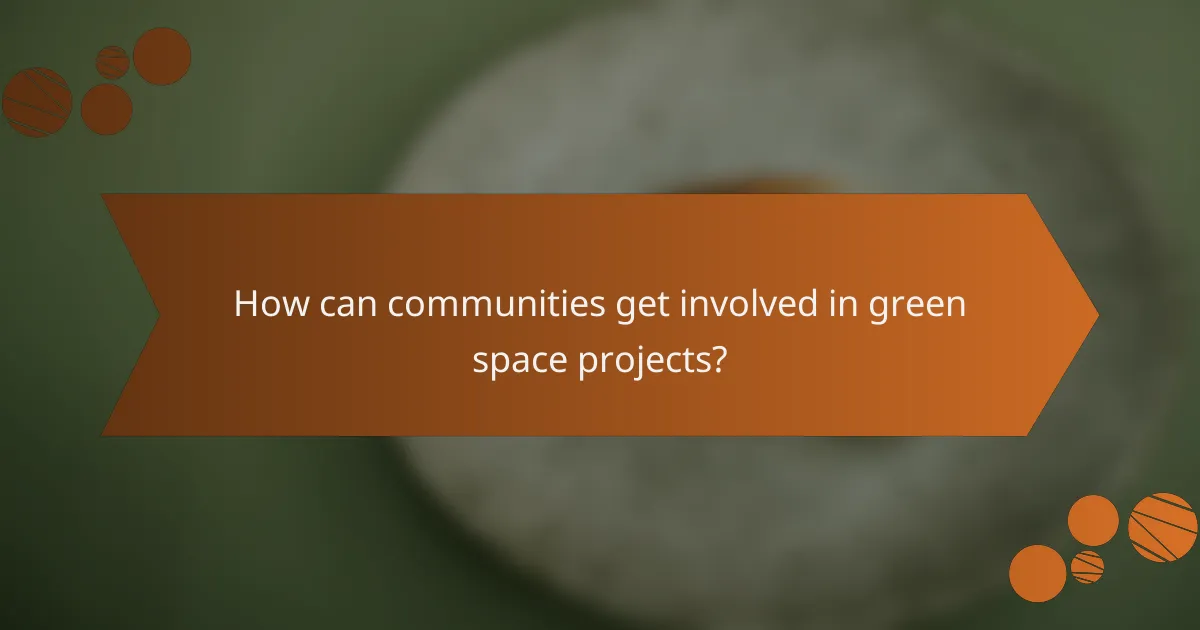
How can communities get involved in green space projects?
Communities can engage in green space projects through various avenues such as volunteering, attending meetings, and forming partnerships with local organizations. These activities foster collaboration and ensure that the needs and desires of residents are met in the planning and development of green spaces.
Volunteer opportunities
Volunteering is a direct way for community members to contribute to green space projects. Local parks and recreation departments often seek volunteers for activities like planting trees, maintaining gardens, and organizing clean-up events. Interested individuals can typically find opportunities through community boards or local government websites.
Moreover, many organizations host regular volunteer days, which can be a great way to meet neighbors and learn more about the specific needs of your local green spaces. Participating in these events can also enhance your skills in gardening, landscaping, and environmental stewardship.
Community meetings and workshops
Community meetings and workshops are essential for gathering input and ideas from residents regarding green space projects. These gatherings allow individuals to voice their opinions, share concerns, and suggest improvements. Local governments often announce these meetings through newsletters, social media, or community bulletins.
Workshops may also provide educational resources, helping residents understand the benefits of green spaces and how to maintain them. Attending these events can empower community members to take an active role in shaping their environment.
Partnerships with local organizations
Forming partnerships with local organizations can amplify the impact of green space projects. Nonprofits, schools, and businesses often have resources, expertise, or funding that can support community initiatives. Collaborating with these entities can lead to more comprehensive and sustainable projects.
Communities should reach out to local environmental groups or civic organizations to explore potential partnerships. These collaborations can result in shared events, funding opportunities, and broader community engagement, ultimately enhancing the quality and accessibility of green spaces.
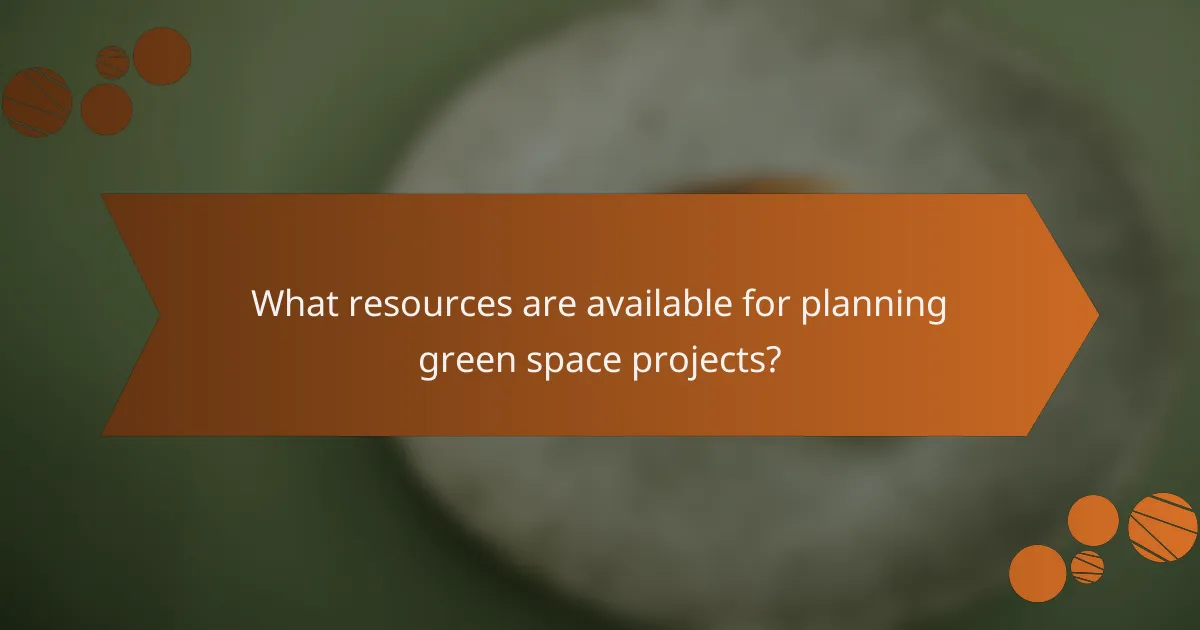
What resources are available for planning green space projects?
Various resources can assist in planning green space projects, including city planning guidelines, grants, funding sources, and online planning tools. Utilizing these resources effectively can enhance project feasibility and community engagement.
City planning guidelines
City planning guidelines provide essential frameworks for developing green spaces. These documents often outline zoning laws, land use policies, and design standards that ensure projects align with community goals and environmental regulations.
Consulting local city planning offices can provide access to specific guidelines that may include requirements for public input, environmental assessments, and maintenance plans. Understanding these regulations early in the planning process can help avoid costly adjustments later.
Grants and funding sources
Numerous grants and funding sources are available for green space projects, often provided by government agencies, non-profit organizations, and private foundations. These funds can cover costs related to design, construction, and community engagement activities.
To find suitable grants, consider resources like the Land and Water Conservation Fund or local community development programs. It’s beneficial to prepare a clear project proposal that outlines objectives, community benefits, and budget estimates to increase the chances of securing funding.
Online planning tools
Online planning tools can streamline the process of designing and visualizing green spaces. Platforms like GIS (Geographic Information Systems) allow planners to analyze land use, assess environmental impacts, and engage community members through interactive maps.
Additionally, tools such as landscape design software can help create detailed layouts and simulate different design scenarios. Familiarizing yourself with these resources can enhance project planning efficiency and improve communication with stakeholders.
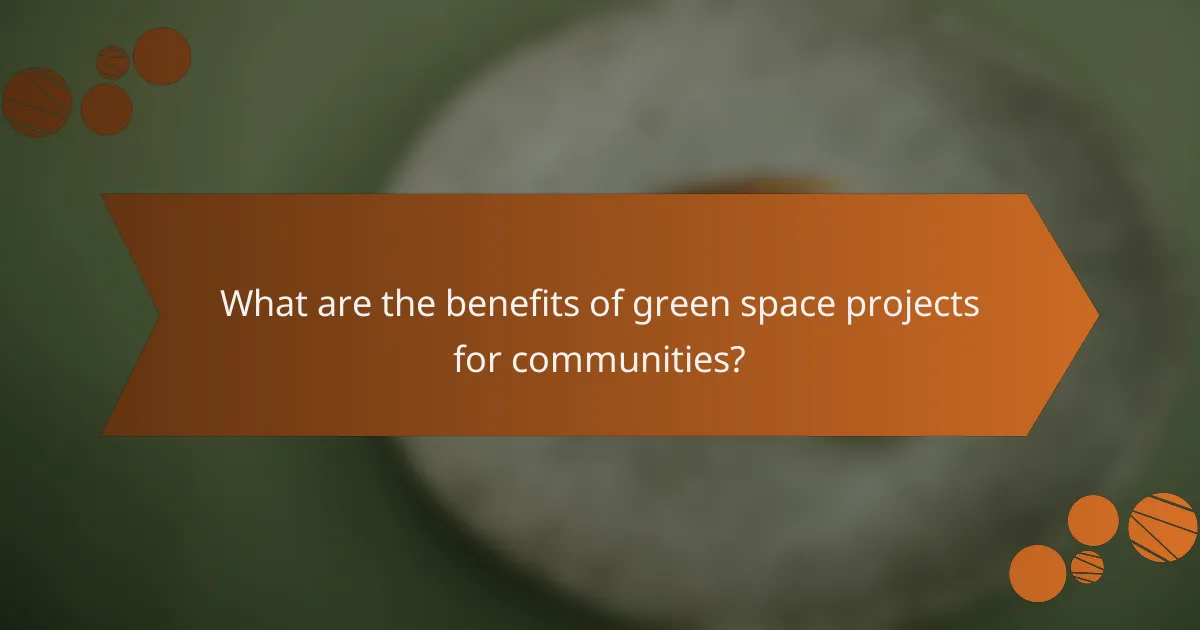
What are the benefits of green space projects for communities?
Green space projects offer numerous advantages for communities, including improved quality of life, enhanced social cohesion, and environmental benefits. These projects create areas for recreation, relaxation, and biodiversity, ultimately fostering healthier and more vibrant neighborhoods.
Improved mental health
Access to green spaces has been linked to better mental health outcomes. Studies suggest that spending time in nature can reduce stress, anxiety, and depression while promoting overall well-being. Community parks and gardens provide a tranquil environment that encourages physical activity and social interaction, both of which are vital for mental health.
To maximize these benefits, communities should ensure that green spaces are easily accessible and designed to encourage use. Features like walking paths, seating areas, and community gardens can enhance the appeal of these areas, inviting residents to spend more time outdoors.
Increased property values
Green space projects can lead to higher property values in surrounding areas. Properties located near parks or well-maintained gardens often see a boost in market value, as many homebuyers prioritize access to green spaces. This increase can be significant, sometimes ranging from 10% to 20% higher than similar properties without nearby green areas.
When planning green space projects, local governments and developers should consider how these spaces can enhance the attractiveness of neighborhoods. Incorporating landscaping, recreational facilities, and community events can further elevate property values and draw interest from potential buyers.
Enhanced biodiversity
Green space projects contribute to enhanced biodiversity by providing habitats for various plant and animal species. Urban areas often lack natural ecosystems, so creating parks and gardens can help restore ecological balance and support wildlife. This is particularly important in cities where development has reduced natural habitats.
To promote biodiversity, community planners should focus on native plant species that require less maintenance and support local wildlife. Implementing features like pollinator gardens, rain gardens, and native tree plantings can create thriving ecosystems that benefit both residents and local fauna.
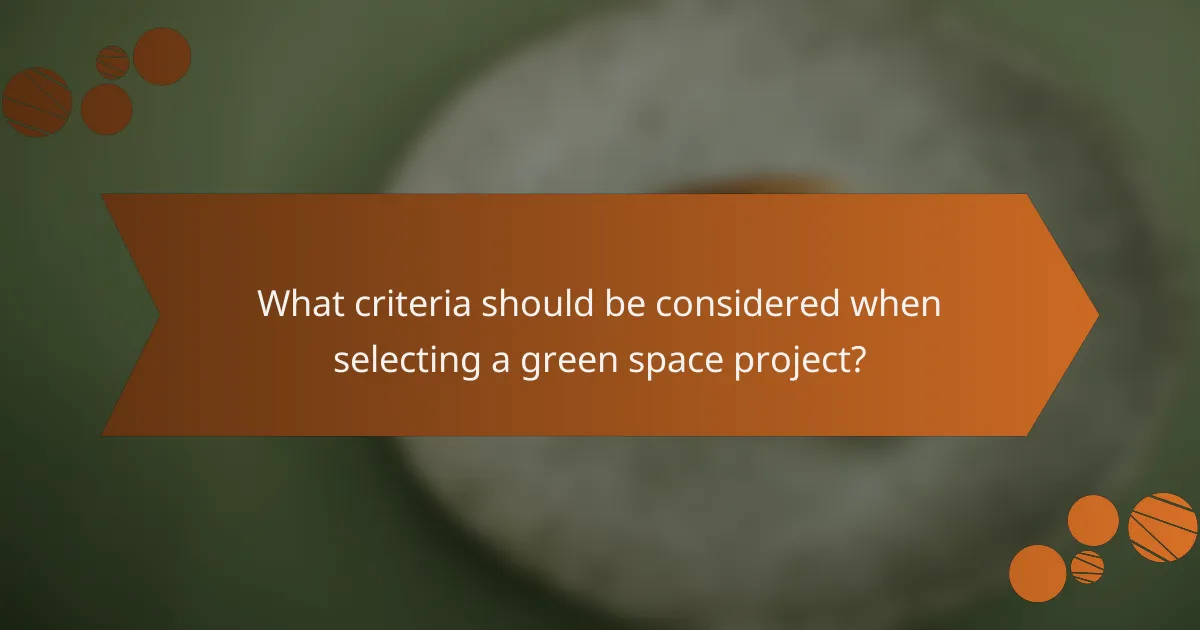
What criteria should be considered when selecting a green space project?
When selecting a green space project, it’s essential to consider community needs, environmental impact, budget constraints, and accessibility. These criteria ensure that the project meets the desires of the community while being sustainable and financially viable.
Community needs assessment
A community needs assessment identifies the specific requirements and desires of local residents regarding green spaces. This process typically involves surveys, public meetings, and discussions with stakeholders to gather input on what features are most desired, such as playgrounds, walking paths, or gardens.
Engaging with diverse community members helps ensure that the project reflects the interests of all demographics, including families, seniors, and individuals with disabilities. Prioritizing inclusivity can lead to a more successful and well-utilized green space.
Consider conducting a SWOT analysis (Strengths, Weaknesses, Opportunities, Threats) to evaluate the potential impact of the project. This analysis can highlight areas where the community may benefit most, guiding decisions on design and implementation effectively.
